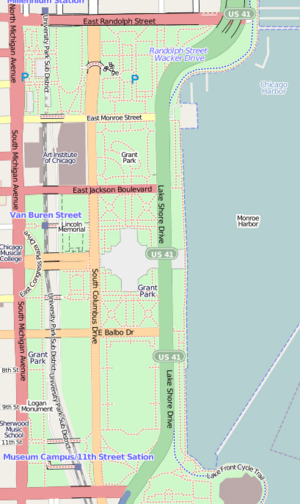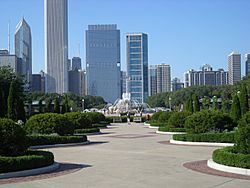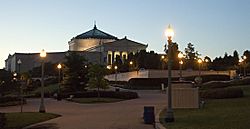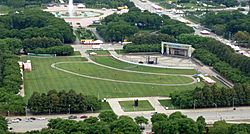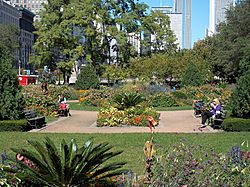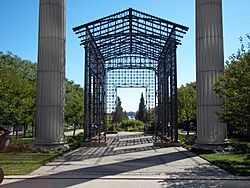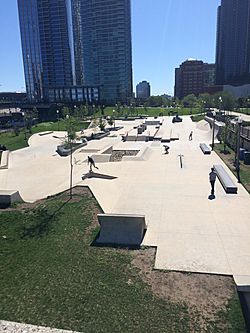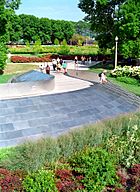Grant Park (Chicago) facts for kids
Quick facts for kids |
|
|
Grant Park
|
|
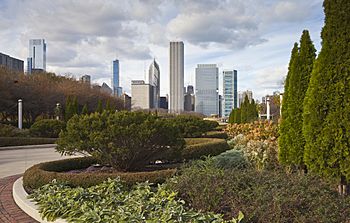 |
|
| Location | Chicago |
|---|---|
| Area | Downtown Chicago |
| Architect | Edward H. Bennett |
| Architectural style | Beaux Arts, Art Deco |
| NRHP reference No. | 92001075 |
| Added to NRHP | July 21, 1993 |
Grant Park is a very large urban park in Chicago, Illinois. It covers about 319 acres (1.29 square kilometers) in the city's main downtown area, called the Loop. This park is home to many famous spots like Millennium Park, Buckingham Fountain, the Art Institute of Chicago, and the Museum Campus.
The park was first called Lake Park when Chicago was founded. In 1901, it was renamed to honor Ulysses S. Grant, who was a US President and a famous general. Over the years, the park has grown bigger by adding new land, often by filling in parts of Lake Michigan. Grant Park is often called "Chicago's front yard" and is managed by the Chicago Park District.
Contents
History of Grant Park
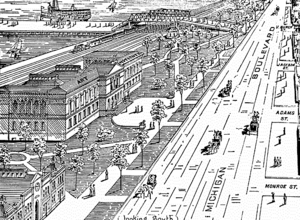
When Chicago was first planned, the land where Grant Park now sits was left empty. People who bought land nearby were promised it would stay open. In 1839, more land was added to the city, and the area east of Michigan Avenue was marked "Public ground. Forever to remain vacant of buildings." This meant no buildings were supposed to be built there.
The city officially made this land a park on April 29, 1844, and named it Lake Park. In 1852, the Illinois Central Railroad built tracks along the lakefront, creating a lagoon that later became dirty. In 1871, much of this lagoon was filled with dirt and debris from the Great Chicago Fire, making the park larger. The city continued to add more land by filling in parts of the lake in 1896. On October 9, 1901, the park was renamed Grant Park. This was to honor Ulylysses S. Grant, who was a general in the American Civil War and later a President of the United States.
For a while, some buildings were put in the park, even though there were rules against it. These included a post office and an early baseball field for the team now known as the Chicago Cubs. However, a Chicago businessman named Aaron Montgomery Ward fought many court battles to keep the park free of buildings. He believed the park should remain open for everyone. The only building he agreed to keep was the Art Institute of Chicago, which was built in 1892.
In the early 1900s, Grant Park grew even more with more landfill. Much of this came from digging tunnels under the city. The park was then designed with a formal look by Edward Bennett. More landfill in the 1910s and 1920s created space for the Adler Planetarium, Field Museum of Natural History, and Shedd Aquarium. These three museums were later connected to form the Museum Campus in 1998. In 2004, a part of northern Grant Park, which used to be train yards and parking lots, was turned into Millennium Park.
Events in Grant Park
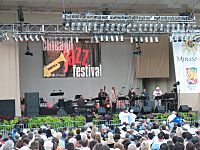
Grant Park has been the location for many big events in Chicago's history.
- In 1865, the park was the starting point for the city's funeral procession for President Abraham Lincoln.
- In 1911, it hosted a large aviation meet where planes flew.
- In 1959, Queen Elizabeth II visited the park to celebrate the opening of the Saint Lawrence Seaway. This spot is now called "Queen's Landing."
- The park was also the scene of protests during the 1968 Democratic National Convention.
- Pope John Paul II held a large outdoor mass here in 1979.
- The park has hosted celebrations for Chicago sports teams, including the Chicago Bulls in the 1990s and the Chicago Blackhawks in 2013.
- In 2008, President Barack Obama gave his Election Day victory speech in Grant Park.
- In 2015, the park hosted the first outdoor National Football League (NFL) draft festival.
- In 2016, the Chicago Cubs held their World Series Championship rally here, with millions of people attending.
The park also hosts several large annual festivals:
- The Taste of Chicago, a big food and music festival.
- The Grant Park Music Festival.
- The Chicago Jazz Festival.
- The Chicago Blues Festival.
- Lollapalooza, a popular rock music festival.
The Chicago Marathon also starts and finishes in Grant Park.
Features of Grant Park
Grant Park is a large, mostly flat area with many attractions. It is crossed by big roads and even sunken train tracks. Bridges help people cross the tracks and connect to Millennium Park. There are also several parking garages hidden under the park.
When the park was first designed in the early 1900s, many tall American Elm trees were planted in rows. While many still stand, some were lost to a disease in the 1970s. New types of elm trees have been planted to replace them.
Millennium Park
The northwest part of Grant Park was updated from 1998 to 2004 to become Millennium Park. This area has many cool art features. Some of these include the Jay Pritzker Pavilion (an outdoor concert venue), the Cloud Gate sculpture (also known as The Bean), the Crown Fountain (with faces that spit water), and the Lurie Garden. Millennium Park is connected to other parts of Grant Park by the BP Pedestrian Bridge and the Nichols Bridgeway.
Maggie Daley Park
Right next to Millennium Park, across the BP Pedestrian Bridge, is Maggie Daley Park. This area is great for outdoor activities. It has skating rinks (for summer and winter), a huge playground, climbing walls, and tennis courts. This part of the park was updated between 2012 and 2015.
Art Institute of Chicago
The Art Institute of Chicago was built in 1893 on the western edge of Grant Park. It is one of the best art museums and art schools in the United States. It is famous for its large collection of Impressionist and American art. Some famous paintings here include A Sunday Afternoon on the Island of La Grande Jatte and Grant Wood's American Gothic.
Buckingham Fountain
The main feature in the center of Grant Park is Buckingham Fountain. It is one of the biggest fountains in the world. The fountain was given to the city in 1927 by Kate Sturges Buckingham to remember her brother. It runs from April to October, with water shows every 20 minutes. There's also a special light and water show in the evenings.
Museum Campus
Chicago's Museum Campus is a 57-acre (23-hectare) area at the southeast end of Grant Park. It is home to three of the city's most important museums, all about natural science: the Adler Planetarium, the Field Museum of Natural History, and the Shedd Aquarium. A narrow path connects this area to Northerly Island, where the planetarium is located.
Petrillo Music Shell
The Petrillo Music Shell is an outdoor stage located at Jackson and Columbus Drives. It hosts many music performances during festivals like the Chicago Jazz Festival, Chicago Blues Festival, Taste of Chicago, and Lollapalooza. The area around the stage, called Butler Field, is used for seating during these events.
Congress Plaza
Congress Plaza is a special entrance on the western side of the park, where Ida B. Wells Drive meets Michigan Avenue. This area has gardens, fountains, and art. It includes two large bronze statues of warriors, The Bowman and The Spearman, which stand like guardians at the park's entrance.
Gardens in Grant Park
Grant Park has many beautiful gardens and flower displays.
- Millennium Park has the Lurie Garden, known for its tall grass flowers and a modern water stream.
- Maggie Daley Park also has tall grass plantings.
- The Richard & Annette Bloch Cancer Survivors Garden is in the northeast part of Daley Park. It has two large columns from an old building and many walkways with plants.
- Near the Art Institute of Chicago Building, there are gardens in the north and south courtyards. The south courtyard has a bronze sculpture called Fountain of the Great Lakes.
- South of the art museum, along Michigan Avenue, are more gardens. Two of these honor past conductors of the Chicago Symphony Orchestra.
- Around Buckingham Fountain, there are formal gardens, including the Tiffany Celebration Garden.
Hutchinson Field
Much of the southern part of Grant Park is called Hutchinson Field. This is a large open space used for big events. It also has many baseball and softball fields, named after Charles L. Hutchinson, a long-time president of the Art Institute.
Chicago Lakefront Trail
A part of the Chicago Lakefront Trail runs along the eastern edge of Grant Park. This trail is 18 miles long and is used for walking, running, and biking along the city's Lake Michigan shoreline. It goes past the Shedd Aquarium and then under a road into Burnham Park.
Marinas and Harbors
Two marinas on Lake Michigan can be reached from Grant Park.
- Monroe Harbor has space for many boats and is home to the Chicago Yacht Club. "Queen's Landing" in this harbor is named after Queen Elizabeth II's visit in 1959.
- Du Sable Harbor, created in 1999, is north of Randolph Drive and offers docks for many boats.
Skate Plaza
The Grant Park Skate Plaza opened on December 6, 2014. It is a 3-acre (12,000 square meter) area for skateboarding and BMX biking. It was designed with help from local skateboarders and bikers. The plaza is in the southwest corner of the park and even includes pieces of limestone from an old train station that used to be there.
Dog Park
Grant Bark Park is a special area for dogs to play off-leash. It is located at Columbus Drive and 11th Street and covers about 18,000 square feet (1,700 square meters). It has asphalt and pea gravel surfaces. Dog owners pay a small fee to use the park, which helps keep it clean and maintained. There are water fountains for both dogs and people. While leashed dogs are allowed in most parts of Grant Park, they are not allowed in Millennium Park.
Other Facilities
Grant Park has miles of shaded walking paths. A full walk around the park's paths is about 4 miles (6.4 kilometers) long. For sports, the park also has 16 softball/baseball fields and 12 tennis courts that are open to the public.
Public Art in Grant Park
Grant Park has a lot of public art, especially sculptures. You can find them in Millennium Park, near Buckingham Fountain, in the gardens, and at Congress Plaza. Here are some of the large sculptures in other parts of the park:
Abraham Lincoln Monument
Abraham Lincoln: The Head of State is a statue of the 16th US President, Abraham Lincoln. It was made by sculptor Augustus Saint-Gaudens and placed in the park in 1926. It is located in the Court of Presidents and is often called Seated Lincoln to tell it apart from another Lincoln statue in Lincoln Park.
Agora Sculpture
Agora is a group of 106 headless, armless sculptures designed by Polish artist Magdalena Abakanowicz. It was brought to the park in 2006. The figures are 9 feet (2.7 meters) tall and weigh about 1,800 pounds (816 kilograms) each. They are made from a special steel that gives them a reddish, rough look. The figures look like a crowd of people walking around.
Logan Monument
At Michigan Avenue and Ninth Street, you can find the General John Logan Memorial. This is a large statue of John A. Logan on horseback, dedicated in 1897. Logan was a major general in the US Army during the Civil War. After the war, he became a US Senator from Illinois.
Additions to Grant Park
Children's Museum Plans
In 2006, the Chicago Children's Museum planned to build a new underground building in Grant Park. The city leaders approved this idea in 2008. However, some people living nearby and other city officials were against the plan. Because it was hard to raise enough money, the Children's Museum announced in 2012 that they would no longer try to build in Grant Park.
See also
 In Spanish: Grant Park (Chicago) para niños
In Spanish: Grant Park (Chicago) para niños


